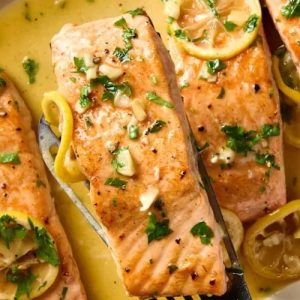
Lemon Butter Salmon
A quick, healthy, and flavorful salmon dish featuring tender fillets sautéed in a lemony butter sauce. Packed with protein and heart-healthy fats, this easy recipe is perfect for weeknight dinners, meal prep, or a simple, elegant meal for any occasion. Ready in just 15 minutes.
Equipment
- 1 large nonstick skillet or frying pan
- 1 spatula or fish turner
- 1 Small Mixing Bowl
- Measuring Cups and Spoons
- Knife and cutting board
Ingredients
- 4 salmon fillets about 6 oz each, skin-on or skinless
- 2 tablespoons unsalted butter
- 1 tablespoon olive oil
- 3 cloves garlic minced
- 1 lemon juiced
- 1 teaspoon lemon zest
- Salt to taste
- Black pepper to taste
- Fresh parsley chopped (for garnish, optional)
Instructions
- Prepare the Salmon Fillets: Start by removing the salmon fillets from the refrigerator about 10–15 minutes before cooking to allow them to reach room temperature. This helps the fillets cook evenly and prevents the exterior from overcooking while the interior remains underdone. Pat each fillet dry with a paper towel—removing excess moisture is key for a nice sear. Lightly season both sides with salt and black pepper, pressing gently so the seasoning adheres.
- Heat the Skillet Properly: Place a large nonstick skillet or frying pan over medium-high heat. Add the olive oil and allow it to warm until shimmering but not smoking. You want the pan hot enough to create a golden crust on the salmon without burning the oil. A properly heated pan ensures that the fish sears beautifully and prevents sticking.
- Sear the Salmon Skin-Side Down (if skin-on): Carefully place the salmon fillets in the skillet, skin-side down if using skin-on fillets. Press gently with a spatula for 10–15 seconds to keep the skin flat against the pan, ensuring even contact. Allow the fillets to cook undisturbed for 4–5 minutes. You’ll notice the color changing from deep pink to a lighter, opaque shade as it cooks—this is a good indicator of doneness.
- Flip the Salmon Fillets Carefully: Once the bottom is golden brown and releases easily from the pan, use a spatula to gently flip the fillets over. If using skinless fillets, just flip when the underside has a nice sear. Cook the second side for 3–4 minutes, depending on thickness, until the salmon flakes easily with a fork but remains moist in the center.
- Make the Lemon Butter Sauce: While the salmon finishes cooking, reduce the heat to medium. Add the butter to the same skillet and let it melt completely. Stir in the minced garlic and sauté for 30–45 seconds until fragrant, being careful not to burn it. Immediately add the lemon juice and lemon zest, stirring to combine. The heat will help the flavors meld, creating a silky, tangy sauce that perfectly complements the salmon.
- Coat the Salmon with Sauce: Spoon the lemon butter sauce over the salmon fillets, tilting the pan slightly to ensure the sauce evenly coats the fish. Baste gently with the back of a spoon, letting the warm butter seep into the fillets. This step enhances flavor, keeps the salmon moist, and gives it a glossy, appetizing finish.
- Check for Doneness: Test for doneness by inserting a fork or the tip of a knife into the thickest part of the fillet. The salmon should flake easily but still be slightly translucent in the center if you prefer it medium. Overcooking can dry out the fish, so aim for tender, juicy fillets.
- Garnish and Serve: Transfer the salmon to individual plates or a serving platter. Spoon any remaining lemon butter sauce over the top. Sprinkle with freshly chopped parsley for a burst of color and a subtle herbal note. Optionally, add thin lemon slices for extra visual appeal and a touch of brightness.
- Serving Suggestions: Pair the Lemon Butter Salmon with simple sides such as steamed vegetables, quinoa, roasted potatoes, or a fresh salad. The richness of the butter and tanginess of the lemon complement light, fiber-rich sides perfectly, creating a balanced, wholesome meal.
- Enjoy While Fresh: Serve immediately for the best taste and texture. The buttery, zesty salmon is most flavorful when hot and fresh, making it ideal for a quick weeknight dinner or an elegant, stress-free meal for guests.
Notes
- Always bring salmon to room temperature before cooking for even searing.
- Pat fillets dry to prevent steaming and ensure a golden crust.
- Adjust lemon juice according to taste—more for tangy brightness, less for subtle flavor.
- Use unsalted butter to control seasoning levels.
- Don’t overcrowd the pan; cook in batches if necessary to maintain a good sear.
- Fresh herbs like parsley, dill, or chives enhance flavor and presentation.
- Serve immediately for the best texture; reheated salmon may lose some of its juiciness.